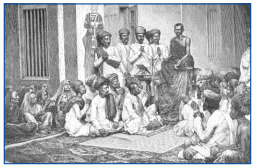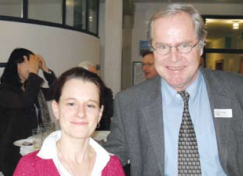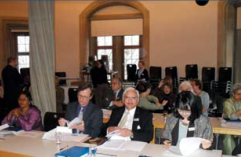
Centre of Jaina Studies Newsletter: SOAS - University of London
The Institute of Asian and Oriental Studies of the University of Tübingen hosted an international conference on 19-20 February 2010, with major funding from Fritz Thyssen Stiftung. The conference was organized by Dr Andrea Luithle-Hardenberg of the Department of Indology and Comparative Religion of the University of Tübingen. It was truly an international workshop, with scholars from eight different countries presenting papers. Dr Luithle-Hardenberg and her colleagues provided gracious hospitality in the charming Swabian university town, and a host of her energetic students ensured that everything went off without a hitch.
In a position paper she prepared for the conference, Luithle-Hardenberg identified two areas in which there is a great need for further scholarship on the interactions between the Jainas and the British during the height of the colonial period in the nineteenth century: Jainas as merchants, and Indological scholarship on the Jainas. The Jainas of western India were successful merchants, entrepreneurs and bankers, and took advantage of the new opportunities provided by British rule. Many of them moved from their traditional areas of activity in Gujarat and Rajasthan to the new economic metropoles of Calcutta and especially Bombay. The British depended on Indian merchants and bankers, many of them Jaina, as essential intermediaries between them and the local economies. The Jaina merchants used this status to advantage, and many of them amassed great wealth. The economic foundation laid during the colonial period has continued into the twentieth and now twenty-first centuries, as Jainas continue to be among the leaders in the development of the Indian economy.
The other area of interaction was intellectual. As part of the colonial project, the British were concerned to amass information about their new subjects. Indology therefore came to play an ever increasingly important role in the nineteenth century, as British administrators, missionaries and academics devoted themselves to the study of India. In this process they were greatly assisted by the rapid growth of Indology in German-speaking academia. Here again, the British were dependent upon their Jaina subjects for access to information that was contained in the living tradition of Jaina intellectuals and in the many Jaina manuscript libraries. Nineteenth-century studies of the Jainas were subject to limited access to reliable and adequately comprehensive information. Jaina Studies, therefore, developed slowly and haltingly.
Indology and Jaina Studies were closely tied to the rise of the comparative study of religion, and so most early studies of the Jainas focused solely upon Jainism as a religion. Historians, sociologists, anthropologists and economists, on the other hand, have paid scant attention to the religious allegiances of the merchants, bankers and industrialists whom they studied, even though many of them were Jainas. Although the connection between religious worldviews and economic practices was central to Max Weber's grand project of the comparative study of religions, and he devoted an extensive discussion to the Jainas based upon the limited information available to him, scholarship that brings together the growing information on the religious practices and beliefs of the Jainas as Jainas, and the economic practices of the Jainas as merchants, remains underdeveloped in Jaina Studies.

19th-century illustration of Jains praying in Bombay. From: Emil Schlaginweit, Indien in Wort und Bild. Eine Schilderung des indischen Kaiserreiches. Band I. (Lepzig: Schmidt & Günther, 1880).
The dozen papers that were presented over the two days well-represented these two areas identified by Luithle-Hardenberg in her position paper. Half of them dealt with the social history of the Jainas during the colonial period. Peter Flügel (SOAS) discussed some Jaina martyrs and other freedom fighters who played important roles in the Indian struggle for independence, and who have received almost no attention from scholars of either Jainism or modern India. Gira Gratier Shroff (independent scholar, Brussels) provided valuable information on the migrations of Jainas to Bombay in the nineteenth century, by focusing on the history of her own ancestors, who came to Bombay from Surat around 1830. Mahesh Joshi (Saurashtra University, Rajkot) provided a broad overview of the social and economic positions of Jainas during the colonial period. Hawon Ku (National University, Seoul) argued that a long series of legal cases over the ownership of the Shvetambar pilgrimage shrines at Shatrunjaya, stretching from 1820 to 1926, contributed to the construction of Jaina identity, as seen through changes in temple patronage and maps of the sacred site. Bal Patil (Jain Minority Forum, New Delhi) brought the focus into the present with a long-distance Skype presentation of the reasons some Jainas are agitating for legal status as a minority community. Sushil Premchand (independent scholar, Mumbai and Zürich) also provided a paper based on family history, of another Gujarati migrant to Bombay from Surat. He looked at the financier, investor, developer, and social patron Premchand Roychand, who was one of the most famous merchant princes of nineteenth century Bombay. Natarajan Rajalakshmi (Madras University, Chennai) discussed how concepts of economic development might be understood through Jaina ethical values.
The other half of the conference involved papers that dealt with questions of historiography, as they investigated the social and intellectual processes involved in the development of Jaina Studies. Two of the presenters, Nalini Balbir and Christoph Emmrich, were unfortunately unable to be present. The paper by Balbir (University of Paris, Sorbonne) discussed the interactions between British scholars and Jaina monks and laymen involved in the searches for Sanskrit manuscripts funded by the colonial government. John Cort (Denison University, Ohio) shifted the focus from Britain and Germany to the United States, by investigating the scholarship of the first three American scholars of Jainism and their studies of Jaina narrative literature. The paper by Christoph Emmrich (University of Toronto) examined the role of Tamil texts in the construction of modern South Indian histories of the literatures of the Dravidian languages. Anna Aurelia Esposito (University of Würzburg) looked at the many German Indologists who played central roles in establishing Jaina Studies outside of India. Peter Flügel's paper, already referred to above, included a discussion of the ways that Jainas controlled the flow of information on Jainism that was provided to European scholars, and thereby exhibited a degree of agency often denied Indians and Asians by post-colonial critiques of Orientalism and Indology. Andrea Luithle-Hardenberg (University of Tübingen) shared her research on the unpublished manuscript from the early nineteenth century by Brigadier Alexander Walker, a British colonial official, entitled Account of the Jeyn, or Shravaca Religion. This account, based upon the author's frequent personal interactions with Jaina laymen and monks in Gujarat, shows again how the growing British understanding of the Jainas was dependent on the Jainas themselves. Leslie Orr (Concordia University, Montreal) shifted the focus to the 'Madras School of Orientalism', and how these early-nineteenthcentury scholars came to an understanding of Jainism different from that of the more famous Calcutta Orientalists, yet an understanding that increasingly finds confirmation in contemporary scholarship.

Andrea Luithle-Hardenberg and Georg Pfeffer

In the front row: Natarajan Rajalakshmi, John Cort, Sushil Premchand, Hawon Ku
Several broad themes emerged over the two days that tied together the many papers, and bridged the gap between social history and historiography. The papers all addressed issues of religion and power, and religion and economics. (Discussions addressing the connections between religion and culture were noticeably less.) As a result, agencythe agency of Jaina intellectuals, Jaina merchants, British colonial officials and scholars. nonBritish Indologistswas a dominant theme. The papers explored the manifold ways that the Jainas were deeply enmeshed in global processes of the nineteenth century: colonialism most obviously, but also the flows that collect under the broad rubrics of globalization and modernization. None of the papers addressed the interactions between Jainas and Christian missionaries, as part of another important global flow in the nineteenth century; this was identified as an area for fruitful future research. Nor did any of the papers adopt either a subalternist or post-colonialist theoretical framework.
What C. A. Bayly in his magisterial 2004 The Birth of the Modern World 1780-1914 has framed as the long nineteenth century saw profound changes in every aspect of human existence. New technologies and new intellectual paradigms spread irresistibly and seemingly inevitably to all parts of the globe. The Jainas were therefore part and parcel of these changes, and the papers at the conference reflected this. Among the changes discussed at the conference were new forms of migration; new market economies; new concepts of ownership and private property; new legal conceptions of the person as a rights bearing and property owning individual; new intellectual paradigms of history; new scholarly practices of critical scholarship, critical editions of texts, and translation; and the growth of print culture.
The fruitful conversations of two days in February will not be restricted simply to fond memories. Andrea Luithle-Hardenberg is planning to use selected papers from the conference, along with other papers newly recruited, to edit a volume with the working title Co-operation and Competition, Conflict and Contribution: The Jaina Community, British Rule and Occidental Scholarship from the 18th to the Early 20th Century. This will be a welcome addition to the growing library of Jaina Studies.
 Prof. Dr. John Cort
Prof. Dr. John Cort